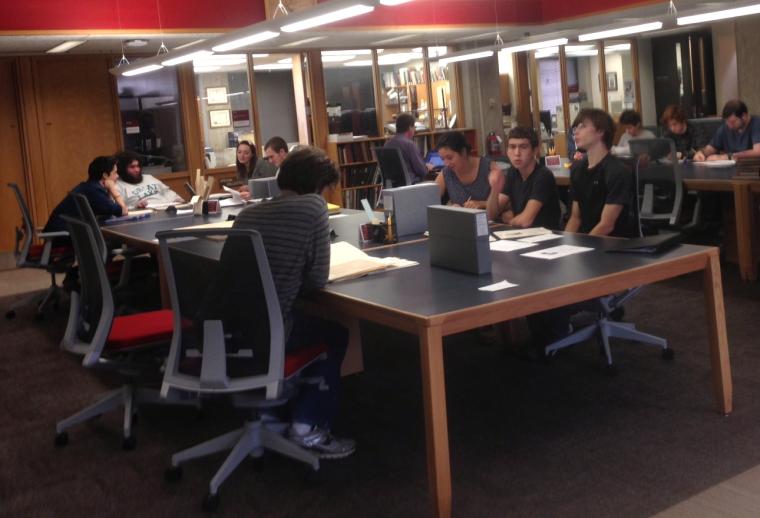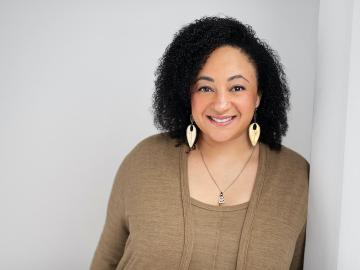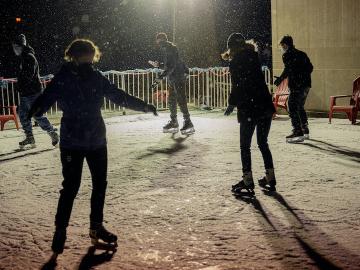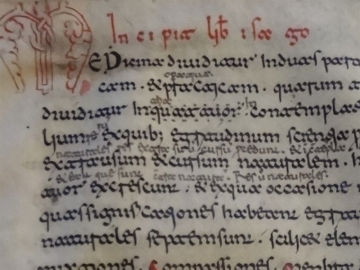Campus News
Strengthening Community Ties Through Local History
January 12, 2015
Lisa Gulasy

How an Oberlin College student perceives Oberlin history often differs from a community member’s view. This is one of many lessons students learn in the course Oberlin History as American History, taught by Carol Lasser, professor of history and director of the Gender, Sexuality, & Feminist Studies Department. Lasser created the course in 1997 as she and a team known as the Electronic Oberlin Group were working to publish local history online.
“We started to get resources on the web, and we were interested in how these would work in classes, both at the college and in the high school,” Lasser says. “Over the years, getting Oberlin history online began to take a second seat to getting college students to do local history projects partnered with high school students.”
In the early days of the course, Lasser’s students worked with elementary, middle, and high school students in Oberlin schools, but “that became really unwieldy,” Lasser says. So when Oberlin High School teacher Kurt Russell proved highly enthusiastic about the projects, Lasser jumped at the opportunity to establish a long-term partnership. “We had such a fabulous set of experiences working together that we’ve just kept it going,” she says. “We have worked together for a very long time.”
Last semester, Lasser’s students were partnered with high school juniors in Russell’s International Baccalaureate History of the Americas class. Local history research topics aligned with the themes Russell was teaching in the class, including “wars in the 20th century, peacemaking and peacekeeping 1918-1939, and the Cold War,” according to Lasser. With the help of Oberlin College Archivist Ken Grossi, Lasser and Russell developed topics teams could research that fit with these themes and were tied to ample resources at the college archives.
Each time the course is taught, and before assigning research topics, Russell will create pairs of his students, and Lasser will meet with her students to learn more about their work styles and strengths and weaknesses. Then, the two educators form complementary teams of high school and college students. “Making this work involves a lot of matching: matching students up, and then matching them up with topics,” she says.
In the beginning of a semester, Lasser gives her students an “intensive introduction to Oberlin history” as well as a crash course in using the college archives. “As a historian, I want students to know there’s more out there than what you can find on the Internet,” Lasser says. “There’s something really thrilling about holding old paper. We hope to give students some of that excitement by giving them the chance to play with primary documents.”
For the first time in fall 2014, Oberlin History as American History students received guidance and coaching from writing associate Lara Griffin. A senior history and gender, sexuality, and feminist studies double major, Griffin was a student in Lasser’s First Wave American Feminisms course her sophomore year. Since then, she has tutored high school and middle school students through the Ninde Scholars Program, which provides academic support and college access services to first- generation college applicants in grades 7-12. She also served as a student teacher in Russell’s Race, Gender, and Oppression class.
In addition to putting together a website with Oberlin history documents, Griffin gave presentations to Lasser’s students. “I was working with college students about how to work with high school students on their writing,” Griffin says. “High school students often have really structured writing assignments—assignments they don’t often have a lot of agency in. The college students had to learn how to give them structure while still giving them agency to write about what they want.”
Lasser and Russell require each high school student to write a five-page paper and each team to share their research findings in a 10-minute presentation given at the end of the semester. Lasser’s students assist the high school students by “pre-searching” documents for them to use, explaining historical context related to the topic they are researching, and helping frame their papers by writing an introduction and conclusion as well as “connective tissue” to tie it all together.
“I require the high school students to have four primary sources, I require them all to analyze a visual, and every team has to do an oral history or an interview,” Lasser says. Carol Ganzel, retired American Civil Liberties Union (ACLU) leader and Oberlin College employee; John Elder ’53, pastor of the First Church in Oberlin 1973-1991; and Tim Scholl, professor of Russian and comparative literature, are just a few examples of people interviewed by students in the past.
It’s by way of these interviews students often realize how greatly perspectives can differ between groups. “History looks different if you’re situated out of the college than it does if you’re a member of the college community,” Lasser says. “It’s not right or wrong, it is that you can have multiple perspectives. Sometimes those perspectives come together, and sometimes they don’t.”
As one team related during its presentation, the October 26, 1967, protest in which 53 Oberlin College students surrounded the car of a Navy recruiter as he was driving toward the college, perspectives can vary greatly. There were some college students, the team said, who disagreed with the protestors’ methods surrounding this event and other anti-war protests happening around the same time, for example.
“This is not Oberlin history as a shiny penny,” Lasser says. “I want the students to understand the different perspectives people can have on the same set of events. That it looks differently, that you relate to it differently, that it holds a different level of importance.”
According to Lasser, there are many reasons Oberlin College students are interested in taking this course. “Some of my students are exploring whether they want to become teachers, some students will tell me it was important for them to explore what’s going on in high school classes other than the ones they were in, and some take it to feel more connected to the town,” she says.
After the fall 2014 semester, however, having Lasser as a professor is not a reason to enroll in Oberlin History as American History. That’s because Lasser is retiring in a year and a half, making the most recent class her last. “It’s my secret hope that I could find a way to teach it at least once more,” Lasser says. “I can’t believe it’s the last time.”
Whether she teaches another round or a different professor takes the reigns, Lasser says she hopes the course will continue because the students find it worthwhile. Griffin concurs: “I think a lot of students have ambitious ideas about how they want to engage with the high school, but they don’t really have an understanding of how it works or even what high school students’ lives are like,” she says. “[This course] is a great way for college students to learn about the community and build reciprocal relationships. I wish I had taken it.”
Tags:
You may also like…
Who is Candice Raynor?
April 12, 2021
You may know that Candice Raynor is a member of the Africana Studies Department, but did you know that her nickname pays tribute to her great grandmother’s wish? Find out how in this installment of Who Am I?
This Week in Photos: Spring Semester Begins
February 12, 2021
Outdoor activities, live-streamed concerts, and socially distanced classes are underway for the spring semester.
Teaching in the New Normal: The Study of Medieval Medical Manuscripts in the Time of COVID-19
July 16, 2020
In this series, we're sharing stories from faculty on how they are navigating this new normal. Professor of Classics Ben Lee describes a group's conduct collaborative research on pre-modern medical history.


